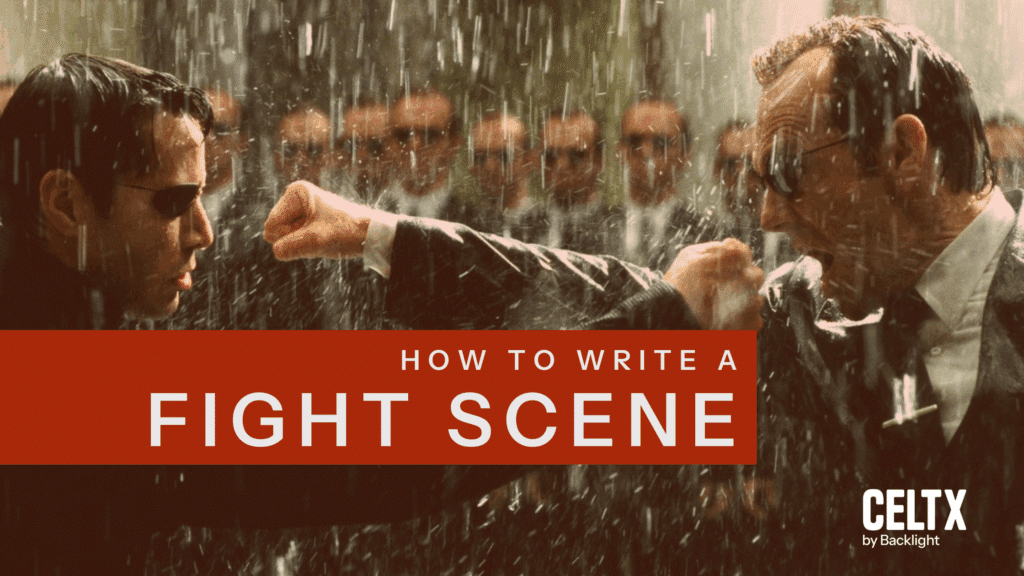
Every flailing fist and broken bone is prime storytelling real estate! While fight scenes in action movies are adrenaline-filled moments that capture the audience’s attention, they can also provide emotional climaxes, character revelations and turning points that can shift narratives in a whole different direction.
While fight scenes can range from a brawl in a back alley to a nail-biting sword duel on a rain-slicked roof, writing an effective fight scene is as much about what it reveals as what it punches into a pulp!
We’re guessing you’re here because you want to know how to write your own killer fight scene. Well, let us delay no longer as in today’s blog, we’ll be diving into how to craft fight scenes that resonate both visually and emotionally. From structure and pacing to formatting, we’ll cover all you need to know!
Also stay tuned for some standout examples of fight scenes that pack a punch.
3…2…1, let’s go!
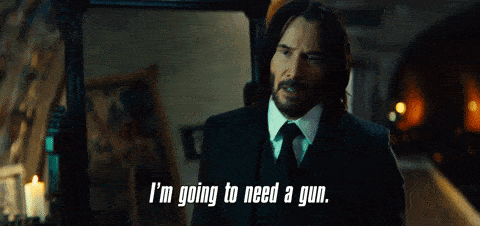
In This Article
- What Makes a Great Fight Scene?
- How to Write a Fight Scene: Writing Action that’s Visual, Not Just Violent
- Pacing & Tension: Letting the Scene Breathe
- Fight Scene Formatting (Inline vs. Sluglines)
- Examples: Best Fight Scene Moments in Screenwriting
- Common Mistakes to Avoid
- Conclusion
What Makes a Great Fight Scene?
A great fight scene isn’t defined by how many people are involved or how much blood is spilled. Yes, both these elements make things exciting, but fight scenes should also add greater depth to a narrative.
How? We’ll let’s see:
Character
Consider who’s fighting and why? What’s are each of the fighter’s motives?
These questions are crucial to identify the underlying tone of the fight. For example, a fight between two childhood best friends would look very different to one between strangers.
Stakes
Next, we need to think about what each character stands to lose in the fight. This adds to the emotional weight of the scene, giving the audience something to root for (or not!).
Emotion
Are the character’s motivations driven by rage, fear, revenge, desperation or duty? This is what fuels the fight, not the physical action.
Purpose
Consider how the fight moves the plot forward or reveals something about the characters themselves. All fight scenes should have a clear purpose, or they shouldn’t be there.
We like to think of fight scenes as “conversations with consequences”. Every blow landed and received by a character is a beat in a conversation which says something about the characters, the story, and the world they inhabit.
How to Write a Fight Scene: Writing Action that’s Visual, Not Just Violent
Screenwriting is all about the visuals and when you’re writing a fight scene, nothing changes.
Screenplays are just the blueprint for what will eventually happen on screen. You don’t need to choreograph every single punch, but to paint a clear picture that directors, actors, and stunt coordinators can interpret and work with.
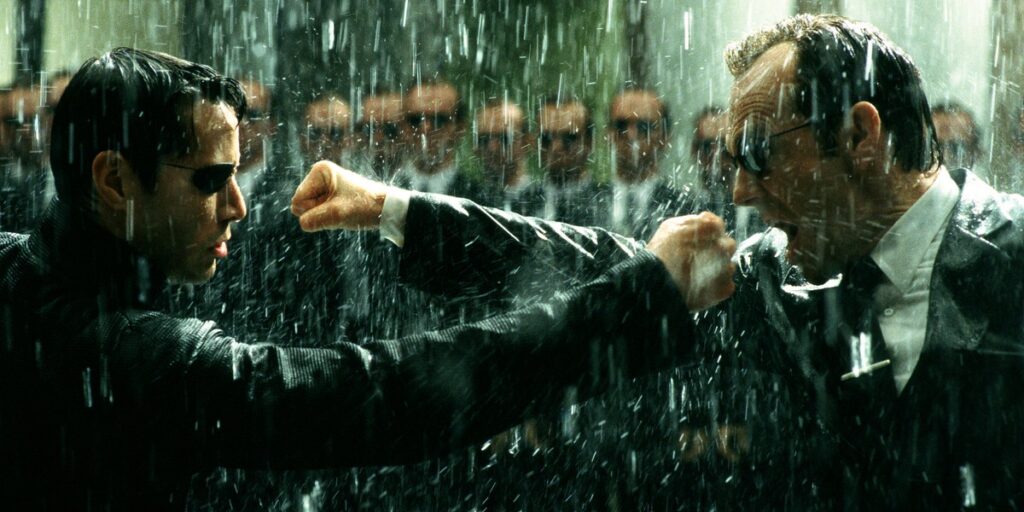
Fight scenes are a careful balance. You want to be specific in your writing but without overloading.
Don’t just write:
Jack and Tom fight. It’s brutal.
This is too vague and gives actors and directors almost nothing to work with. Let’s spice things up a little.
Jack ducks Tom’s first punch – barely. He stumbles backward, grabbing a beer bottle off the table.
SMASH! The bottle shatters across Tom’s shoulder.
Reeling, Tom grabs Jack by the collar and SLAMS him into the fridge.
Here, we can see three clear visual moments of the sequence. We’ve used CAPITALS to highlight movement and sound, as well as separated the action lines to insinuate pace as it could play out on screen.
Notice how we’ve also used active visual verbs that convey motion clearly. Words like ducks, lunges, slams, pivots, drives, crashes, rips, and tumbles immediately tell us what’s happening in the most economical and visual way.
Verbs truly are your best friend as a screenwriter and can even be used to convey emotion. Avoid vague or internal language when writing characters and instead hint at emotion through physical responses.
Say you want to show that your hero is afraid as they battle their enemy.
He’s afraid.
This doesn’t tell us very much visually. Instead, we want to use physical motion to show this. Instead, try something like this:
His eyes dart around the alley. Breath shallow. Hands trembling.
Not only does this convey so much more but also lands us right in the middle of the action and resonates with the character’s feelings.
The key thing to remember is that filmmaking is ultimately a collaborative process, so trust those you’re working with to bring your writing to life. Focus on highlighting key moments of the scene but let the rest move briskly on.
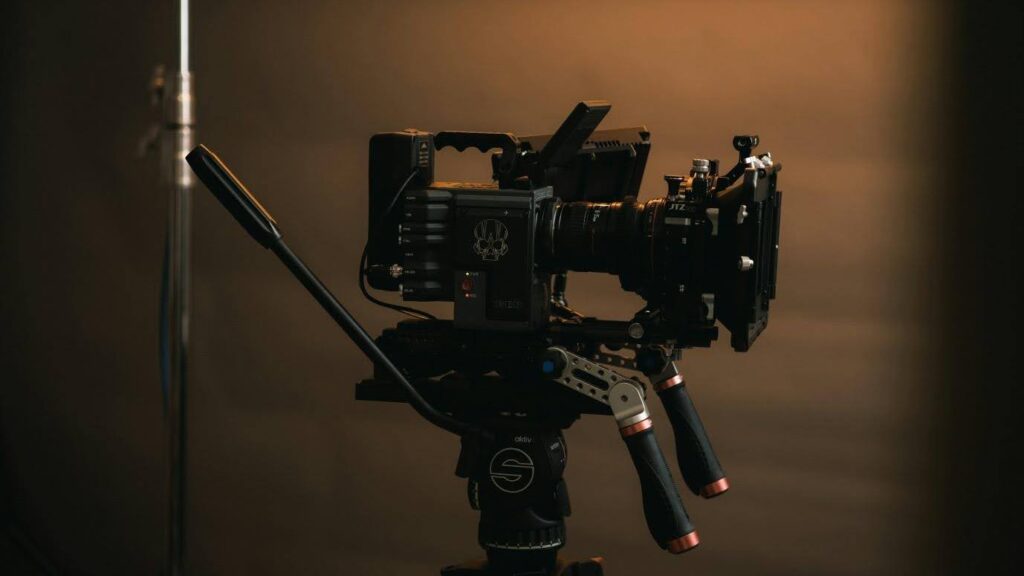
Make every punch land — without your formatting pulling any.
Celtx’s script writing software handles the structure so you can focus on the fight.
Sign up for free.
Pacing & Tension: Letting the Scene Breathe
While we’ve briefly touched on pacing, let’s take a closer look!
If you haven’t guessed already, pacing is vital in a fight scene. Too fast, and you’ll miss it. Too slow and the energy will fizzle out very quickly.
But how do you strike the perfect rhythm in a fight scene?
Savvy Sentence Structure
Punchy sentences are great for rapid blows or chaotic scuffles between fighters. For example:
A punch. Another. Blood. He gasps. Drops to one knee. Looks up – CRACK! Boot to the jaw.
On the other hand, you can use longer sentences to slow the tempo down for moments of tension, hesitation, or realization. Just like this:
She circles him, watching his eyes. One wrong move and it’s over.
Breathe Between Blows
Not every moment in your fight scenes needs to be action-packed and fast moving. You can also insert alternative beats that ground the action in reality.
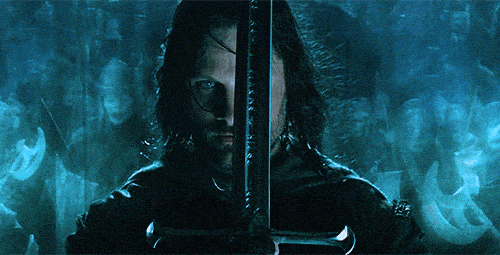
Moments like this could include:
Character Realization
Amongst the chaos, a character could realize something.
She sees the knife. The one she gave him.
Environmental Interaction
The characters take a break (albeit a momentary one) from interacting with each other, the setting playing a larger role in how the scene plays out.
They crash through the window into the alley below.
Power Shifts
It’d be pretty dull if one character dominated the scene. Think about how you can switch things up and keep the audience on the edge of their seats, constantly guessing what could happen next.
Now she’s the one in control. Her blade inches from his throat.
Not only does breaking the fighting up with moments like this keep the audience engaged, but they also add dimension, giving them room to process and feel. The last thing you want is for viewers to become desensitized to your story.
Fight Scene Formatting (Inline vs. Sluglines)
How you format your fight scene can make a huge difference in terms of readability and clarity. By using a variety of inline action and sluglines, you’ll be well on your way to crafting a kickass battle!
Directors, actors, and stunt coordinators need to be able to easily transfer your writing onto the screen, so make it easy for them with our top three tips on fight scene format.
1. Inline Action
Inline action does exactly what it says on the tin. Everything happens on the line, which is ideal for quick exchanges, especially in a running fight or confined space.
He ducks under her swing – grabs a chair – WHACK! She stumbles; spits blood.
The use of hyphens can be useful in separating out short bursts of action while keeping things flowing.
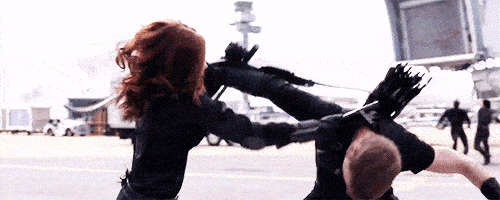
2. Sluglines
You can also use sluglines to mark key changes within the scene such as new locations, new beats, or emotional shifts.
INT. PARKING GARAGE – NIGHT
He sprints between cars. Tires SCREECH behind him. A shadow drops from the ceiling – BOOM! – tackles him to the ground.
They roll. Fists fly.
The shadow reaches for their gun – he KICKS it away. Sprints for the exit. The shadow in pursuit.
EXT. PARKING GARAGE – NIGHT
Weaponless, the shadow disappears into the dark.
As we change from an internal to external setting, we use a slugline to separate them. It also signals a shift in the dynamic as the shadow is overwhelmed by our hero, forced to flee the scene.
Capitalize Key Sounds or Movements
While capitalization should always be used sparingly within a screenplay, they can be especially useful in a fight scene for sound and sudden impacts.
A window SHATTERS.
CRACK!
SMASH!
This of course is more for the benefit of the reader, but it draws in their eye and emphasizes key turning points within the scene.
Examples: Best Fight Scene Moments in Screenwriting
Now let’s see some of the screenwriting greats in action. Studying successful screenplays can really help you elevate your own fight scenes. Here are just a few of the best fight scenes out there:
1. The Matrix – Neo vs. Agent Smith
The Wachowski sisters’ ground-breaking script for this memorable scene is a masterclass in rising tension and shifting stakes. They have choreographed the action clearly and with impressive rhythm.
However, the most important aspect of the scene is how it serves the characters. It not only grows Neo’s confidence as the protagonist but also makes Agent Smith a more ruthless antagonist.
We see Neo go through moments of hesitation throughout the scene, until he finds his true strength from within.
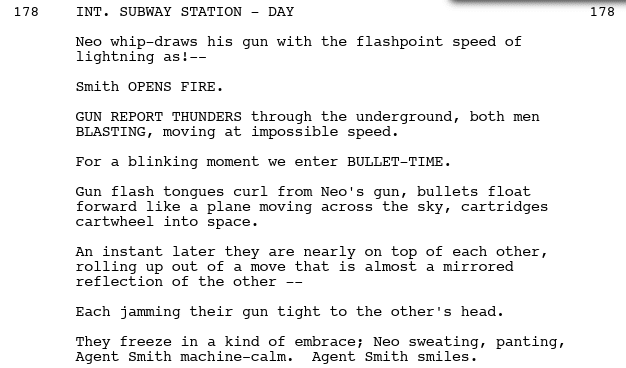
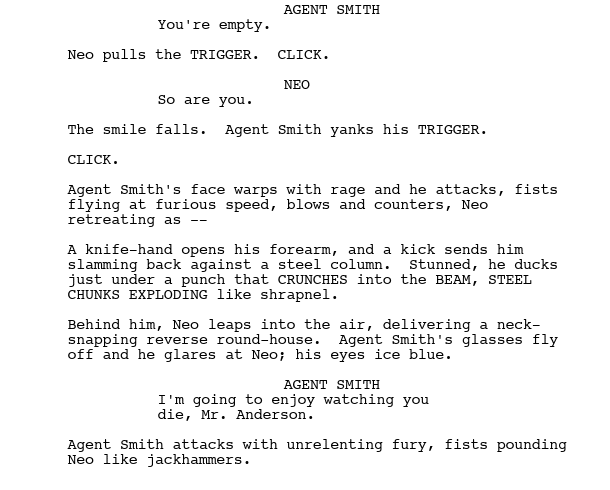
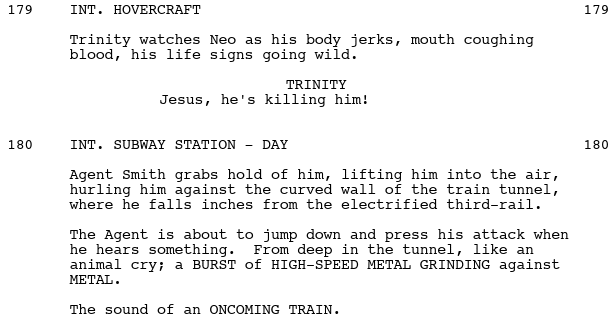
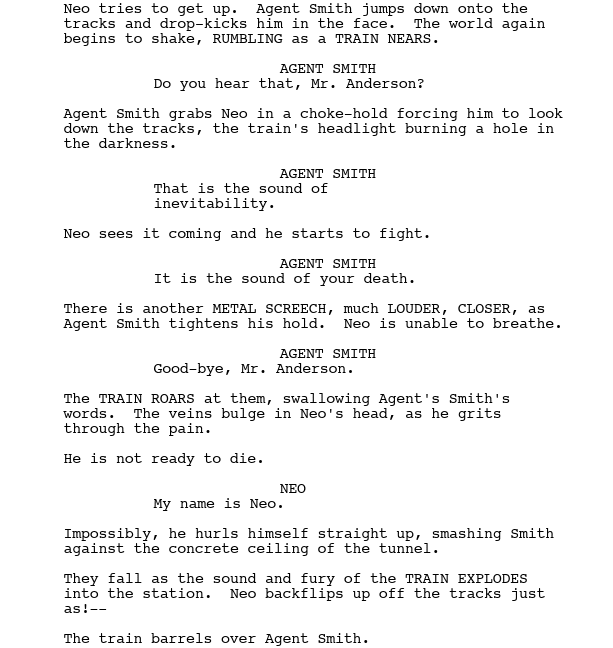
Now let’s see the scene play out before our very eyes:
2. Kill Bill Vol 1. – The Bride vs. The Crazy 88
Tarantino’s style is unique as is his pacing within this famous fight scene. Yes, it’s a long fight but the variety of tempo and rhythm alongside its emotional highs and lows, keeps us gripped all the way through.
Notice how Tarantino uses capitalization for emphasis and inserts pauses throughout the scene of The Bride standing, bloodied and surrounded by bodies.
As the film’s director also, he has added in cinematic effect through color and sound to heighten the tone.
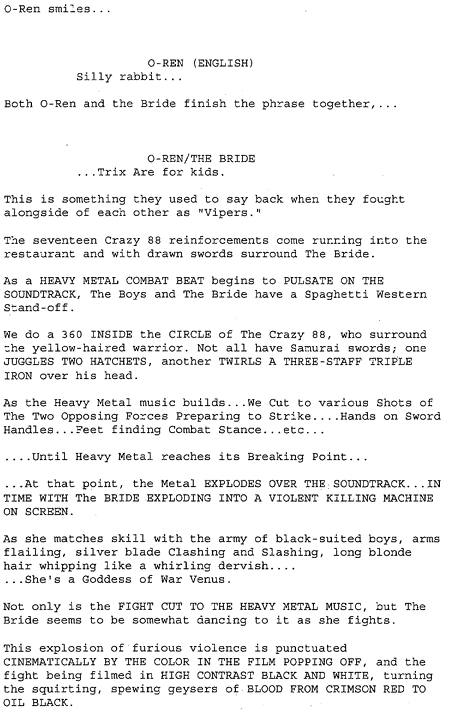
You can watch this scene in action on YouTube

Don’t let clunky pacing be the final blow.
With Celtx screenwriting software, you can plan every beat like a pro.
Click here to start your free trial!
Common Mistakes to Avoid
We all make mistakes as writers, and it’s all part of the learning process. However, there are always pitfalls we can dodge! Here are our top six things to avoid when writing your fight scenes.
1. Overchoreographing
It can be extremely tempting to note down every single movement and look between characters, but you don’t need ten lines to describe a single move.
Remember, we’re writers, not fight choreographers, so make sure to keep the action lean, focused and cinematic.
2. A Lack of Emotional Stakes
A fight without stakes is just moving pictures and noise. Before you start writing, make sure you know why the fight is happening and what will change when it’s all over.
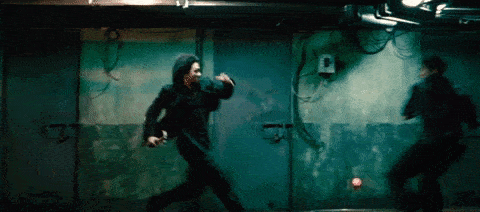
3. A Consistent Rhythm
All fights are unpredictable so this should be mirrored in your writing. Make sure to mix sentence lengths, vary action and add beats in to create tension.
4. Ignoring the Environment
The space around your fight should affect the action. For example, a brawl in a cramped kitchen will feel very different to one in a forest or on a rooftop. Make use of props, obstacles and the setting to heighten the action.
5. Telling Instead of Showing
The age-old mantra ‘show don’t tell’ strikes again! Avoid internal thoughts unless you can convey them visually through action such as trembling hands, darting eyes and backing away.
6. Too Many Characters
It’s hard to follow ten people in a melee unless you’re an extremely efficient viewer. When writing, focus on a few key characters and choreograph around them – organized chaos, if you will.
Conclusion
A fight scene should do more than entertain and should evolve the story. Whether it’s a brief scuffle or an all-out war, every move must matter.
Remember:
- Show don’t tell.
- Prioritize emotion over motion.
- Let action serve character and stakes.
- Pace with precision.
When done right, a fight scene becomes a character’s crucible—the place where their fears, flaws, and strengths are tested. It’s not just about who wins. It’s about who changes.
So next time you write a fight scene, ask yourself: What story am I really telling when the fists start flying?
Ready to throw down your best scene yet?
Celtx helps you write, revise, and fight your way to a killer script.
[Click here to sign up.]
Up Next…

From Zero to Hero: How to Write an Action Movie Script
Now that you know how to write a killer fight scene, learn how to write an action movie screenplay, from high-stakes plots to cinematic pacing.
Click here to start reading!
